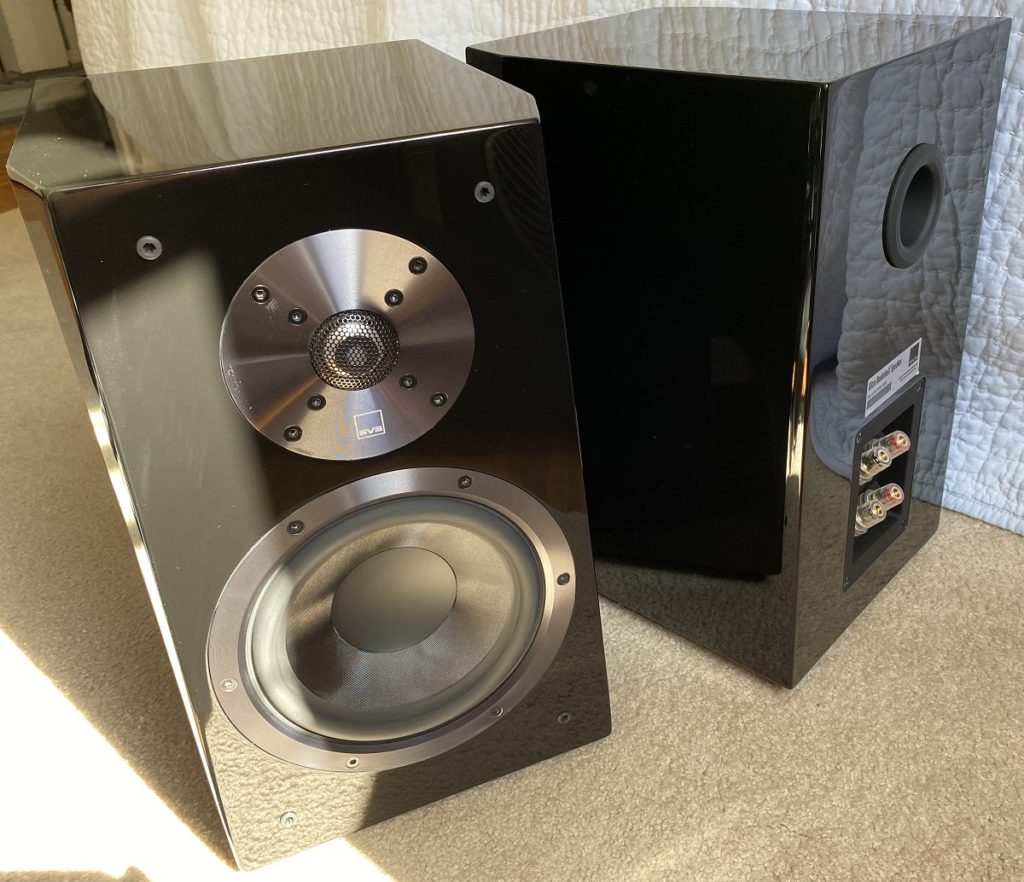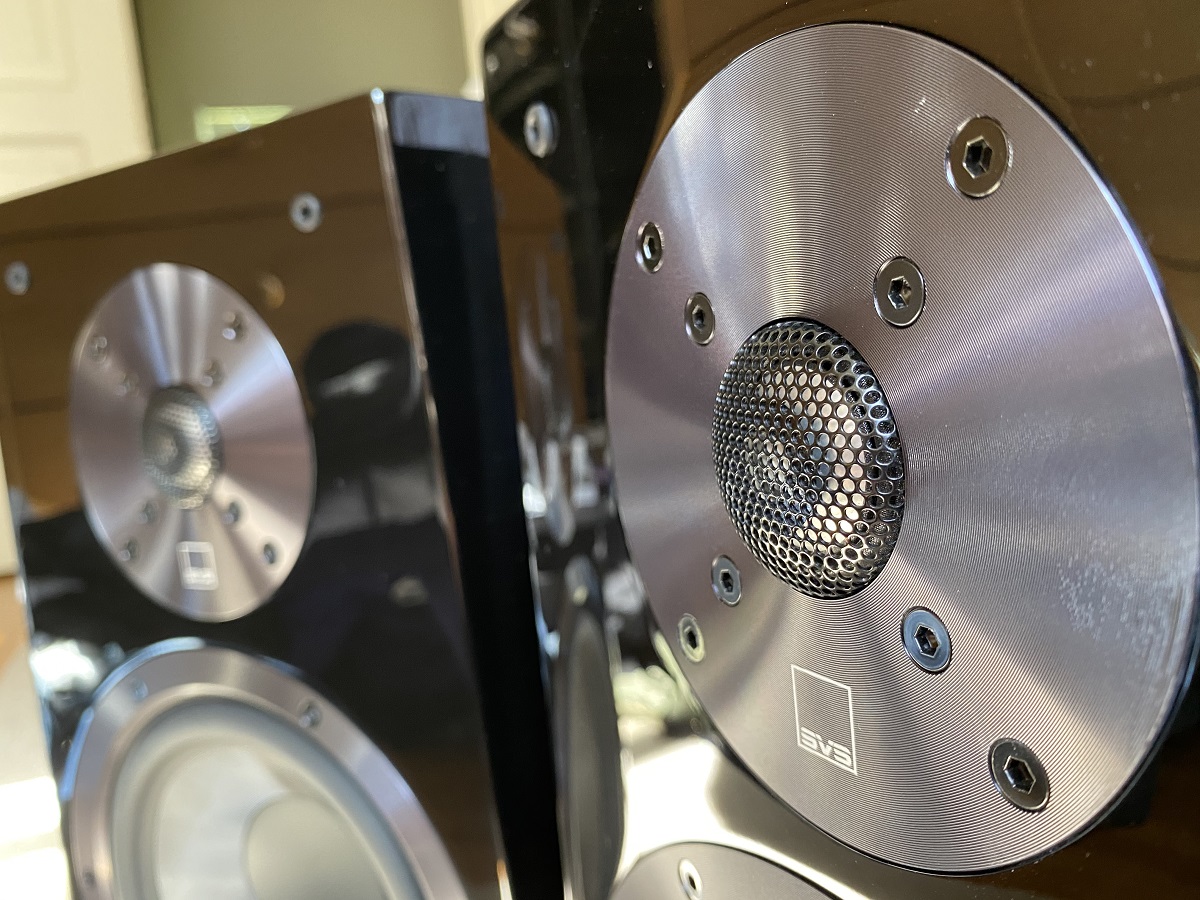For the past 22 years, SVS has been perfecting their craft in the world of subwoofer design. They are perhaps best known for their flagship 175 lb Ultra Series subwoofer. A pair of bookshelf speakers sharing the company’s Ultra Series name has a lot to live up to.
Are they bass-heavy party speakers that remind you of a pair of vintage Cerwin Vegas? Or, are they a balanced and versatile speaker that can handily compete with other audiophile speakers at this highly competitive price point? I requested a pair of the SVS Ultra Bookshelf Speakers ($999) and took a close listen to this bass-loving company’s approach to bookshelf speaker design.
Design and Build Quality
My review sample featured a dapper-looking piano-gloss black finish. They’re also available in a plain black oak veneer, but the piano-black option doesn’t cost extra so it’s a no-brainer to opt for this gorgeous premium finish. Gunmetal grey anodized aluminum trim rings provide contrast against the obsidian finish, surrounding both the 1″ aluminum dome tweeter and 6.5″ glass-fiber woofer. The tweeter sits behind a protective mesh grille, which features an integrated diffuser to uniformly dissipate its treble energy. The woofer’s composite glass-fiber material and long-stroke motor were selected for high power-handling capability. Both the tweeter and woofer are custom-manufactured to SVS’s specifications.
The overall build quality was good, but I noticed a few lighter-colored streaky areas on the aluminum trim rings. Perhaps it’s left over polishing compound from the piano gloss finishing process. One of the tweeter assembly’s allen-head bolts wasn’t screwed down completely flush like the others. These aren’t glaring offenses, but it prevents the SVS Ultras from having the flawless level of fit and finish which I’ve seen on others speakers at this price.
On the rear, you’ll see two sets of gold-plated binding posts, and a 1.7” port made from a matte black rubberized material. Peering inside the port, I noticed the cabinet was filled with a large amount of white damping material. Out of sight is SVS’s in-house designed SoundMatch crossover network. It’s a second-order Linkwitz-Riley design that consists of two copper inductors, one polypropylene capacitor, one electrolytic capacitor, and one sand-cast resistor.
Performance and Sound Signature
This is a detail-lover’s dream speaker. I could hear that nothing was coming between me and every single micro-detail inside the music. The overall presentation of the sound is on the forward side, combined with a slightly cool tonality. The interplay of sounds between the two speakers formed a uniform and seamless wave, with an expansive and airy stereo image. The speaker’s ability to start and stop on a dime demonstrated impressive agility and speed. Crisp leading-edge transients and satisfying center-locked vocals round out the SVS Ultra’s box-less sound.
The aluminum dome tweeter never sounded metallic, nor exhibited any unpleasant frequency-specific resonances. However, it did have a tendency to sound bright with modern pop and electronic music. Sometimes this comes with the territory of a revealing metal-dome tweeter, and is a tradeoff for the level of insight they offer. The treble is prominently showcased; this isn’t a speaker that’s forgiving of inferior source material.
The midrange was neutral, with no unnatural bloom or bloat. However there was still body and presence in these frequencies, along with an accurate tonality that easily passed my jazz piano listening tests. Like the tweeter, the woofer offered me a limitless examination of the subtlest details.
Bass response was linear and flat without boosting, coloration, or mid-bass bloat. Despite the rear-ported design, it didn’t limit placement options or create boomy bass even when close to wall boundaries. I appreciate that SVS took a neutral approach to the low-frequency reproduction, as opposed to making them great party speakers. They’d definitely pair up nicely with an SVS subwoofer to gracefully fill in their low-frequency response.
Amplifier and Music Pairings
Norma Audio REVO IPA-140: The Norma integrated amplifier slightly bolstered the SVS Ultra Bookshelf’s low-frequency response. It demonstrated an introspective and engaging upper midrange, with vivid tonality and gutsy presence. The sound had a good sense of space and wasn’t entirely localized to the speakers themselves. The rhythmic drive and bouncy dynamics of the Hideaki Yoshioka Trio’s “Wired” were reproduced perfectly. When I played Art Blakey & The Jazz Messengers’ “Down Under”, the peaks and valleys of Art’s unmistakable swing and cadence were lively and involving. The SVS and Norma combination successfully conveyed the energy and excitement of upbeat jazz.
MastersounD BoX: This tube amp pairing slightly smoothed out the SVS Ultra’s treble response, without affecting the speed and attack of the speaker. I decided to take a classical music journey with Rachmaninov’s Piano Concerto No. 3 in D Minor. I chose the 1982 recording of Riccardo Chailly conducting Martha Argerich and the Radio-Symphonie-Orchester Berlin. I selected this performance due to Ms. Argerich’s impressive display of instrumental prowess throughout this intricate and daunting Rachmaninov piece.
The SVS Ultra’s detail retrieval allowed me to hear every single piano note played. There was nothing lost or blurred, even during complex passages where the soloist’s staccato key strikes ramp up in intensity to near-impossible speeds. I closed my eyes and could hear the desperation in Ms. Argerich’s piano, as it intertwined with the lush and romantic swells of the orchestra’s strings. The MastersounD and SVS pairing gave me an introspective and rewarding rendition of this stunning performance.
Final Thoughts
The SVS Ultra Bookshelf speakers can compete against established audiophile speaker brands, while showcasing their unique sound quality. They excel at providing an expansive and engaging soundstage. Their ability to project satisfying center-locked vocals is admirable.
The aluminum dome tweeter did have a tendency to sound intense and peaky with some songs, especially at higher listening levels. There were a few times when I wanted to turn up the volume on a track, but the treble energy became too forward and bright so I had to reduce the volume instead. These speakers were likely voiced for both music and home theater use, to highlight the sparkle of glass breaking or the zing of bullet ricochets. However, in my 13×10’ listening room the treble was ultimately too intense for my taste.
The SVS Ultra Bookshelf speakers represent a logical choice for a listener who likes a lively, upfront, and dynamic speaker. They will thrive in a system that sees equal use for both music and movies. If you are looking for more excitement and energy in your listening experience, the SVS Ultra Bookshelf speakers are worth an audition.






Hi can we expect a review of the Revo 140? Also maybe a vs with pure audio one.
Thanks
Hi Capt Prashant Pathreeker,
Indeed, I’m planning on a formal review of the Norma integrated. However, I am only at about the 150 hour mark, of the 200-300 required hours for the unit to be fully broken-in per the user manual.
So I continue to log time on it in order to fully realize it’s performance capabilities. Look for a full review later this year and thanks for reading The Audio Beatnik!
Drew
Have you reviewed the Prime bookshelf?
Hi Jules – I’ve not reviewed or heard the Prime bookshelf, but it appears to use the same tweeter so I would imagine that it’s treble performance is similar.
Best,
Drew